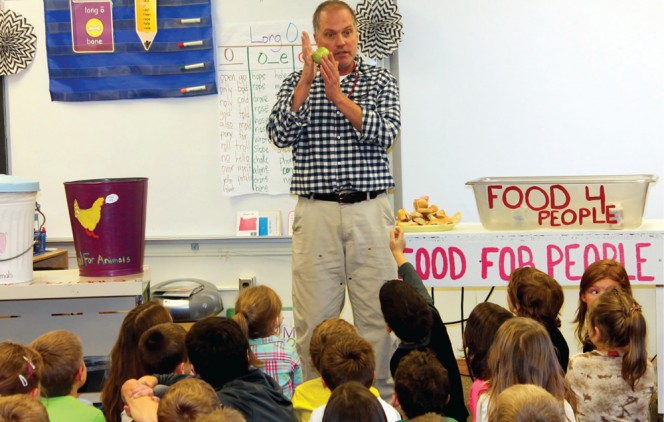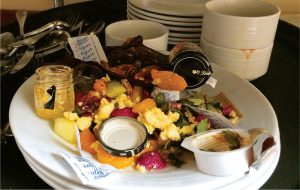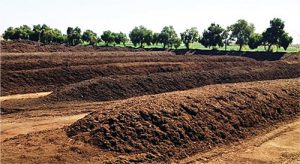BioCycle November 2015

Clark explains the food waste separation project to students in his Living Environment class at Parishville-Hopkinton Central School in Parishville, New York.
Parishville, New York: Walking The Food For People, Food For Soil Walk
How does a high school teacher from rural northern New York launch a food recovery and recycling program? Step One: Attend the BioCycle/EPA Workshop, Food For People, Food For Soil, held on October 19 as part of BioCycle REFOR15. Step Two: Dive in! This “live” report comes from Glenn Clark, a biology and wilderness studies teacher at Parishville-Hopkinton Central School who completed Step One and has embarked on Step Two:
“My Living Environment class is working on a food waste separation project in school. The rationale is to reduce waste by ‘rescuing’ perfectly good food, separating food scraps for animals (pigs, chickens) and then composting the remaining organic waste. The success depends on getting the kids on board. We did a soft opening in the cafeteria yesterday. It was like trying to poke a cat from under the porch with a wet rope! But we did have some success, rescuing some food and feeding some chickens and pigs. In the teachers’ room, we put a black bin that says feed the chickens. If teachers want to participate while having lunch, they can scrape their vegetables, bread etc. and we will collect it after 1:15 pm. I am also asking teachers if there may be time in their common core schedule to allow us to visit their room and explain the program. I told them I can make it mathematical! We are taking a trip to Clarkson University next week to tour its facilities, including organics source separation procedures, cold weather food production and the anaerobic digestion operation.” Stay tuned for the next update of Walking The Food For People, Food For Soil Walk.
Emmaus, Pennsylvania: Food Scraps Diversion At BioCycle REFOR15
BioCycle, in collaboration with the American Biogas Council, HDR Engineering and Black Earth Compost, put a plan into action to collect and compost all food scraps and food-soiled paper generated at BioCycle REFOR15, held last month at the DoubleTree Boston North Shore in Danvers, Massachusetts. HDR met with Black Earth and hotel staff to determine how to set up the program, as this was the DoubleTree’s first foray into organics diversion. Two breakfasts and two lunches were served, along with refreshment breaks. Over 600 people attended BioCycle REFOR15 events. HDR and Black Earth worked with the hotel’s chef and staff to make the process as easy as possible. The team added five lined totes throughout the venue including one in the chef’s food preparation area, one at the staff’s dishwashing station and three others around the wait staff’s bus areas. Several easy-to-follow training handouts provided in English and Spanish detailed which foods and materials were compostable. Conor Miller from Black Earth Compost stated it simply: “If it was once alive, we will compost it!” This included paper napkins, paper plates, decorative flower arrangements, wood and bones.
Each afternoon (October 20 and 21), Black Earth collected the totes and left new prelined ones for the next day. Materials collected were transported to Black Earth’s facility in Gloucester, Massachusetts, about 15 miles from the DoubleTree, where they were composted. Miller estimates that 500 pounds of “very clean” food scraps were collected from the BioCycle REFOR15 conference. “Everyone involved was not only pleased with the ease of executing the composting program but, more importantly, proud to see the benefit food waste composting can have on the environment and their community,” notes Christopher Koehler, Solid Waste Section Manager with HDR in Boston. To learn more about this program, contact Janine Ralph at Janine.Ralph@hdrinc.com.
Calgary, Alberta: Large-Scale Composting Facility Under Construction
Calgary — at 1.2 million, Alberta’s most populous city and the heart of the province’s oil industry — has begun construction of a $143 million (Cdn) indoor/outdoor composting facility, said to be the largest of its kind in Canada. Located on an existing landfill site, it is scheduled to open in mid-2017, the same time as Calgary plans to launch residential curbside collection of source separated organics from single-family homes. The facility will be able to process up to 110,000 tons/year of household food scraps, leaves and yard trimmings, along with 11,000 tons of dewatered solids from the city’s wastewater treatment plant. Food waste and yard trimmings comprise more than half of Calgary’s residential waste stream. The curbside collection program will let residents combine them in a single green bin for weekly pickup. Households will be able to use compostable bags, but not conventional plastic.
The site will be enhanced with trees and embankments, along with a storm water pond designed to look like a natural wetland. The city is financing the facility and selected Chinook Resource Management Group (CRMG) to design, build and operate it. CRMG is a consortium led jointly by Bird Construction and the Maple Reinders Group. AIM Environmental Group is the operations and maintenance provider for an initial 10-year term, and Stantec is the design and permitting liaison. In the future, note city officials, the facility may also accept food and landscaping material from the commercial sector, apartments and condominiums, and other towns and cities.
Chino, California: Diversified Compost Markets
Agromin’s new Chino organics recycling facility is composting green waste collected from surrounding cities into compost used by local growers and commercial landscapers. Agromin expects to produce 50,000 tons/year of compost at the 5-acre site in Chino. Incoming green waste is inspected for nonrecyclable items, which are removed, then ground and put into long windrows that are turned and watered for about 60 days. Three types of products are manufactured: Compost 100, ES-2 cover mulch and Garden Humus. The Compost 100 is approved for use in USDA-certified organic production and food processing and is Organic Materials Review Institute (OMRI) listed. The ES-2 mulch is for orchard applications and use in public works locations and other landscape projects. It meets California Department of Transportation specifications. Garden Humus is designed for sandy soils as it adds structure, nutrients and microbes to the soil to promote healthy plant growth.
In September, Agromin, which owns multiple composting facilities, announced that it received permission from the Ventura County Board of Supervisors to expand an existing operation outside of Santa Paula (CA) on property owned by Limoneira Company, a Santa Paula-based grower. The Board voted to change the zoning rules for agricultural land to allow organics processing operations of up to 100 acres on that property. Agromin still needs a permit from county planners to license the facility. The 70-acre site would process about 200,000 tons/year of green waste and 100,000 tons/year of food waste.















